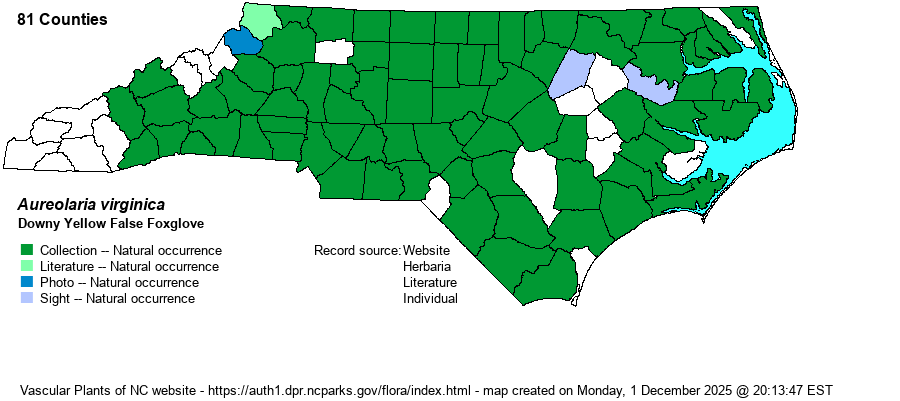| Author | (L.) Pennell | |
| Distribution | Nearly statewide, though might be absent from parts of the Mountain region -- no records for the far southwestern counties. Gaps in parts of the Coastal Plain are not likely real absences.
This is a wide-ranging Eastern species, ranging from New England to northern FL, and west to eastern TX. | |
| Abundance | Frequent to common in the Piedmont. Fairly common in most of the Coastal Plain, though locally uncommon. Infrequent to fairly common in the central and southeastern Mountains. This is the most common of the five Aureolaria species in the state, and the only one with a State Rank of S5. | |
| Habitat | This is a species of mesic oak and oak-hickory forests, being a root parasite on oaks. It can occur in rocky soil, but it typically is found on dry to mesic slopes of hardwood forests. | |
| Phenology | Blooms from May to July, and fruits from August to September. | |
| Identification | This is a fairly tall herb, unbranched or nearly so, and thus wand-like, reaching 3 feet tall or more. The stem is rather scabrous, with a number of opposite leaves along the stem. Each leaf is lanceolate and about 4 inches long and 1.5 inches wide, most with several rounded lobes, of varying depth to the midrib; however, many of the upper leaves are entire, and smaller. The upper 6-10 inches of the stem contains the raceme of large bright yellow flowers, one per leaf axil; each flower is about 1.4 inches long and nearly as wide. The species can look quite a bit like A. levigata at times, if all leaves are entire, but this latter species has smooth stems, whereas A. virginica has pubescent and somewhat rough stems to the touch. Normally, you should be able to see a few leaves with obvious lobes. Both species can grow fairly close together, in dry to mesic oak forests in the mountains and western half of the Piedmont, and thus be careful in the identification. This is a species that should be seen on quite a few walks across the state in drier oak forests, and when in bloom it is impossible to overlook. | |
| Taxonomic Comments | None
| |
| Other Common Name(s) | Downy Oak-leech, Virginia Oak-leech | |
| State Rank | S5 | |
| Global Rank | G5 | |
| State Status | | |
| US Status | | |
| USACE-agcp | | |
| USACE-emp | | |

